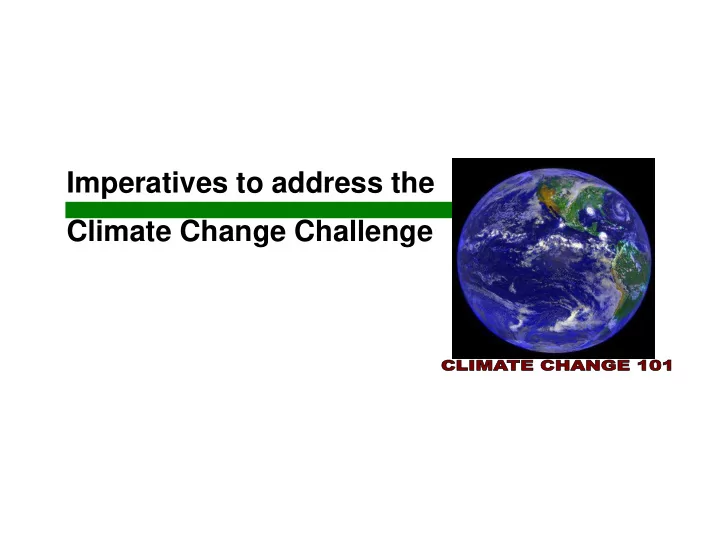

Imperatives to address the Climate Change Challenge
Imperatives to Address Climate Change
The United Nations Framework Convention on Climate Change (UNFCCC) “Laid the foundations of the contemporary global environmental policy “ Adopted on 9 May 1992 in New York and signed by more than 150 countries and the European Community. “stabilization of greenhouse gas concentrations in the atmosphere at a level that would prevent dangerous anthropogenic interference with the climate system.” It contains commitments for all Parties to return greenhouse gas emissions to 1990 levels by the year 2000.
“ While the Convention encouraged industrialized countries to stabilize GHG emissions, the Protocol commits them to do so”. ����������������������������������������������� ����������������������������������������������� �������������������� �!"���������� ���� ���������������������#�����$����������������#���� ��������$����������������� �%��������#����������������������� &'( ����������#��$�������#���������)**+�)*�)( ,���������������������-�����������������)**&(
���������������������������� ������77 ������������������������������� ��������������������������� ����������3���������3���������3� �������3�4�����0�3�5��3� ��������������������������������� !�������3�!������3�6�����*�3� �������������� �������������!��� 6������37�������3�7�������3� ��"���������������#�!���������� 7���*�3�8�����3������������3� $����%�����$����������&%������ 9�����������3�9���:�������3� 9����*�3�#��������3�1�����3� 1������3�1�����������3�;��0�*� 3�<������=�������3�<1� '��(������)�����������*������������������������������������
Article 12: Clean Development Mechanism (CDM) • Assist Parties not included in Annex I in achieving sustainable development • Assist Parties included in Annex I in achieving compliance with their quantified emission limitation and reduction commitments under Article 3 • Assistance Mechanism is through funding of CDM Projects in Developing Countries
Vulnerability to Climate Change
Vulnerability: Agriculture Sector Current climate Agricultural production is highly vulnerable to increasing temperature, particularly, night time temperatures, changes in rainfall events/patterns, particularly those due to extreme weather/climate events, and high winds during tropical cyclone occurrences. Future climate Food security in the Philippines hinges in the agricultural production of the country, principally on sufficiency of rice production.
Vulnerability: Coastal Sector � Sea level rise � land loss and population displacement � increased flooding of low-lying coastal areas � agricultural impacts resulting from inundation, salinization and land loss � impacts on coastal aquaculture � impacts on coastal tourism � Increase sea temperature/ Increase CO 2 � coral bleaching � ocean acidification � impacts on fishery � Socio-economic factors
Vulnerability: Coastal Sector
Vulnerability: Health Sector Indirect cause: Climate sensitive infectious diseases (vector, water borne) • The number of leptospirosis cases is high when the volume of rainfall is high. • The number of malaria cases is high when the mean temperature is high. Direct cause: Floods, storm surge
Vulnerability: Forestry and Watershed Sector The sector now accounts for up to 20-25 percent of the current yearly GHG emissions worldwide. Unsustainable change of land uses poses a big threat to the environment. Loss of forest habitat due to destruction, degradation and climate change is projected to increase plant and animal species loss . Loss of watershed values.
"�� ������ �������� ������� �������� Vulnerability to �$ ��� #������ ������ ������ �%�� &��������'� �������� ����������( specific impacts ����� ��� of climate �������������������������������������������������� change will be �������������������������������������������� most severe ���� ���������������������������������������� when and where Invasive Species: High impact, Continuing trend they are felt Over-exploitation: Low Impact, Continuing trend together with stresses from other sources
Responses to Climate Change
RESPONSES TO CLIMATE CHANGE “ No Regrets Approach “ Adaptation Adaptation Mitigation
Mitigation An anthropogenic intervention to reduce the sources or enhance the sinks of greenhouse gases. Adaptation Practical steps to protect countries and communities from the likely disruption and damage that will result from effects of climate change
Climate Change Mitigation Strategies ������������������������������������ �������� ��� ������������ ������ ��� ���������������� ��
Four Areas of Mitigation �� �������������������� �� ���������������� ��� !� "����#�$����������� %� &����'�(���������
All Sectors and Regions have potential to contribute to reduce GHG emissions or implement CC mitigation measures Note: estimates do not include non-technical options, such as lifestyle changes.
Options to reduce GHG emmisions in the energy sector Technologies and Practices AVAILABLE NOW COMMERCIALIZED BEFORE 2030 � ����������������������������������� � ������������� ����������������������� � ���������������� � ��������������������������������� � ������������������������������ �������������������������������� ��������������������������������� ��������������������������� ��������� CCS- carbon capture and storage �������������������������������������������������)*)��������������������+�,#-.)/��"���0 1���������������0�*)$*.2�&�����32( 4�������������0��32�&�����52(
Options to Reduce GHGs emissions in agriculture Cropland management Restoration of organic soils Rice management
Options to reduce GHG emmisions in Forestry Protection of Forest Resources Reforestation
Climate Change Adaptation Strategies “ Practical steps to protect countries and communities from the likely disruption and damage that will result from effects of climate change” http://www.flickr.com/photos/twml abs/29463820/
Why adapt to climate change?
Adaptation Options 1. Bearing losses 2. Sharing losses 3. Modifying threats 4. Preventing effects 5. Changing uses 6. Changing location http://www.flickr.com/photos/twml 7. Research abs/29463820/ 8. Education, information and behavior change
Recommend
More recommend